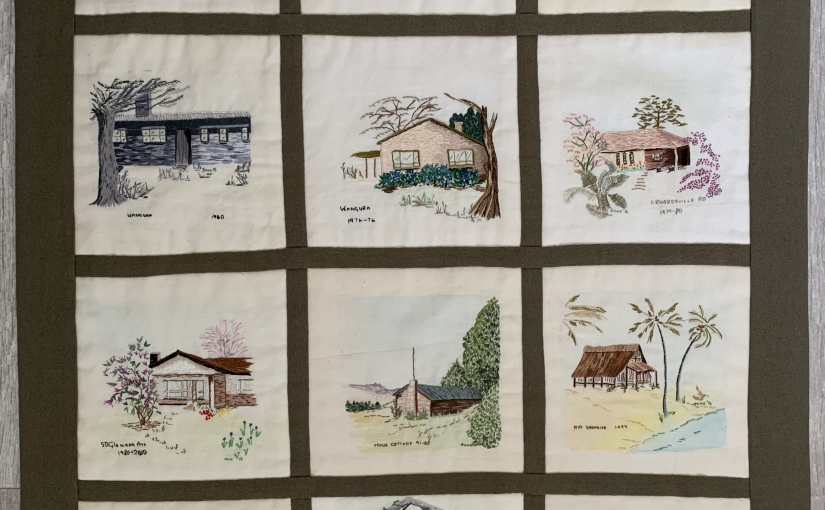For the last few weeks, I’ve been working on two wall hangings for a lady who lives local to me – I don’t usually do ‘commissions’ or requests, but this was different.
A friend of mine had put this lady, Anne, in touch with me in the hope that I could help her create a quilt made up of her embroideries. I wasn’t sure if I’d have the time to work on the project as I was just about to start college whilst also working and running a voluntary group. However, I agreed to meet her, and I’m so pleased that I did.
Anne, who is in her 80s, welcomed me into her little house in town; hanging on the walls were many of her embroideries, of wildlife and landscapes, professionally framed, as well as other artworks by family members.
She also showed me some folders which had even more of her embroideries, each embroidery carefully mounted on card and neatly filed in plastic wallets – she said there too many to frame and she wanted to have them pieced together so that they could be displayed as a quilt or wall hanging rather than tucked away in a folder which no-one would ever see. Anne explained that she wasn’t able to do this herself as she struggles now to hold a needle and sadly can no longer embroider.
One of the folders contained a collection of embroideries of birds and another folder was of the houses she’d lived in throughout her life and to this day. All of her embroideries were beautifully and exquisitely made, and I was in complete awe of her skill.
It was the collection of the houses she’s lived in that really sparked my interest – born in England in 1939 but then moving to Africa in 1948 to live in what was then known as Rhodesia – now Zimbabwe. The collection of embroideries charts her life, through the traumatic struggles in the 1970s, her two marriages and then her return to England in the noughties. Helping her to create the wall hangings was the least I could do, and I resolved to find the time to work on the project.
Since our first meeting, which was a little over a year ago, we’d see each other every few months to discuss what the wall hangings would look like once pieced. There were 12 embroideries in the houses’ collection and 9 in the birds’ collection. We agreed on a 3×4 and a 3×3 layout, respectively, and in terms of how the blocks would be positioned, with the houses it would be in chronological order, and for the birds, in any way that was pleasing to the eye.
Anne wanted the wall hangings to resemble a lead paned window, and I thought it was important that any work wouldn’t detract from the embroideries, so we took our time deciding what fabrics would work best for the sashing, border and backing. Finally, with fabric choices agreed and purchased, and having a small window of no coursework and some time off work, I started working on the project.
The embroideries had been mounted on pieces of card of the same size; the first step was to remove the embroideries from the card, which Anne did before handing them over to me.
I was keen to minimise the amount of work needed on the embroideries themselves, so instead of trimming each block to size with a seam allowance, which is what I would normally do on my own quilts, I trimmed away excess fabric, but kept the natural fold in the fabric from when the embroideries had been mounted on card.
I then pieced the block togethers, butting up the blocks – with their original folds – and sewing them together using a zig-zag stitch.
Next, was to add the sashing between the blocks. Unlike in my usual quilts, where the sashing is sewn between blocks, in this case, I placed the sashing on top of the blocks following the zig-zag seams.
In order to ensure the sashing strips were of the same width, I cut pieces of card to the desired width, and ironed the strips of fabric around the card strips. These were then placed on top of the zig-zag seam and handstitched in place.
Next came the border, and then the wadding and backing. There is no quilting as such on these wall hangings, apart from a few strategically placed cross-stitches to hold the three layers together – again I wanted to minimise any work on the embroideries themselves and was keen that any work done would not detract from Anne’s work. The final part was to add the labels.
I’m really pleased with how they’ve turned out – and so is Anne, which is of course the most important thing. The finished wall hangings are exactly what we had in mind and can now be displayed for Anne and her visitors to enjoy.
For me it was a real labour of love, just like the embroideries have been for Anne.
Mel x
Click here for free patterns.
Click here for an A-Z list of my quilt spots.











What a lovely thing to do Mel, you are very kind. Anne’s embroideries are stunning, what a team you made!
LikeLike
Aaaw thank you Maureen, that’s very kind of you. Mx
LikeLiked by 1 person
Ah! A labour of love indeed! So worthwhile. Lovely that Anne and her guests can now view her beautiful embroideries. I’m really impressed with the way you thought through and executed such careful preservation of each of the pieces.
LikeLike
Thank you Alison! Mx
LikeLike